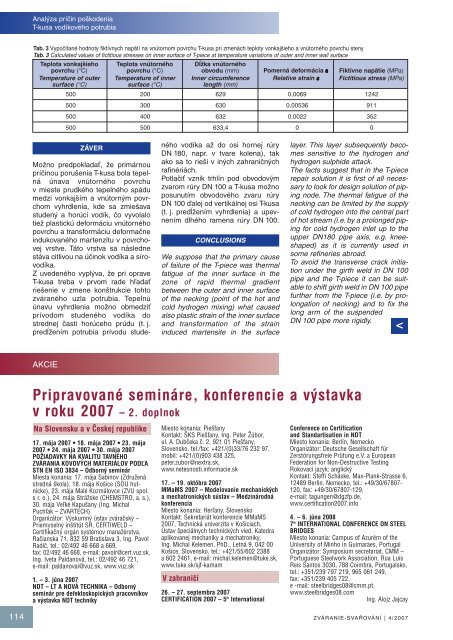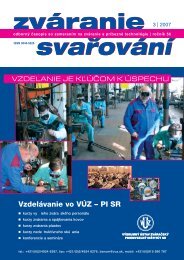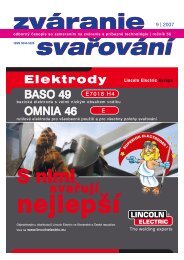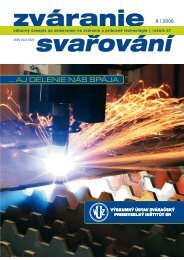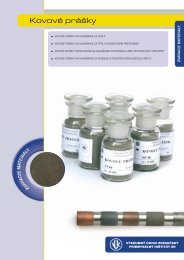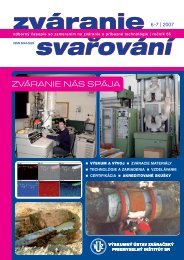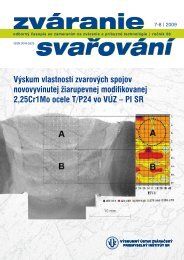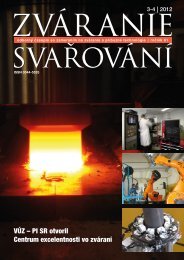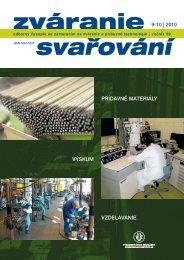zváranie svařování
ABICOR BINZEL - Výskumný Ãstav zváraÄský
ABICOR BINZEL - Výskumný Ãstav zváraÄský
- No tags were found...
You also want an ePaper? Increase the reach of your titles
YUMPU automatically turns print PDFs into web optimized ePapers that Google loves.
Analýza príčin poškodeniaT-kusa vodíkového potrubiaTab. 3 Vypočítané hodnoty fiktívnych napätí na vnútornom povrchu T-kusa pri zmenách teploty vonkajšieho a vnútorného povrchu stenyTab. 3 Calculated values of fictitious stresses on inner surface of T-piece at temperature variations of outer and inner wall surfaceTeplota vonkajšiehopovrchu (°C)Temperature of outersurface (°C)Teplota vnútornéhopovrchu (°C)Temperature of innersurface (°C)Dĺžka vnútornéhoobvodu (mm)Inner circumferencelength (mm)Pomerná deformácia εRelative strain εFiktívne napätie (MPa)Fictitious stress (MPa)500 200 629 0,0069 1242500 300 630 0,00536 911500 400 632 0,0022 352500 500 633,4 0 0ZÁVERMožno predpokladať, že primárnoupríčinou porušenia T-kusa bola tepelnáúnava vnútorného povrchuv mieste prudkého tepelného spádumedzi vonkajším a vnútorným povrchomvyhrdlenia, kde sa zmiešavastudený a horúci vodík, čo vyvolalotiež plastickú deformáciu vnútornéhopovrchu a transformáciu deformačneindukovaného martenzitu v povrchovejvrstve. Táto vrstva sa následnestáva citlivou na účinok vodíka a sírovodíka.Z uvedeného vyplýva, že pri opraveT-kusa treba v prvom rade hľadaťriešenie v zmene konštrukcie tohtozváraného uzla potrubia. Tepelnúúnavu vyhrdlenia možno obmedziťprívodom studeného vodíka dostrednej časti horúceho prúdu (t. j.predĺžením potrubia prívodu studenéhovodíka až do osi hornej rúryDN 180, napr. v tvare kolena), takako sa to rieši v iných zahraničnýchrafinériách.Potlačiť vznik trhlín pod obvodovýmzvarom rúry DN 100 a T-kusa možnoposunutím obvodového zvaru rúryDN 100 ďalej od vertikálnej osi T-kusa(t. j. predĺžením vyhrdlenia) a upevnenímdlhého ramena rúry DN 100.CONCLUSIONSWe suppose that the primary causeof failure of the T-piece was thermalfatigue of the inner surface in thezone of rapid thermal gradientbetween the outer and inner surfaceof the necking (point of the hot andcold hydrogen mixing) what causedalso plastic strain of the inner surfaceand transformation of the straininduced martensite in the surfacelayer. This layer subsequently becomessensitive to the hydrogen andhydrogen sulphide attack.The facts suggest that in the T-piecerepair solution it is first of all necessaryto look for design solution of pipingnode. The thermal fatigue of thenecking can be limited by the supplyof cold hydrogen into the central partof hot stream (i.e. by a prolonged pipingfor cold hydrogen inlet up to theupper DN180 pipe axis, e.g. kneeshaped)as it is currently used insome refineries abroad.To avoid the transverse crack initiationunder the girth weld in DN 100pipe and the T-piece it can be suitableto shift girth weld in DN 100 pipefurther from the T-piece (i.e. by prolongationof necking) and to fix thelong arm of the suspendedDN 100 pipe more rigidly.


